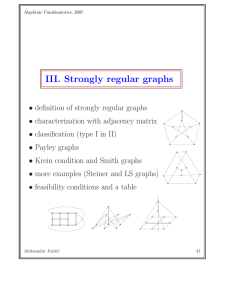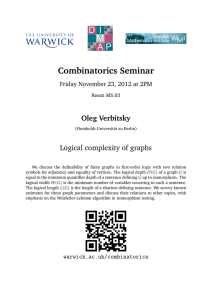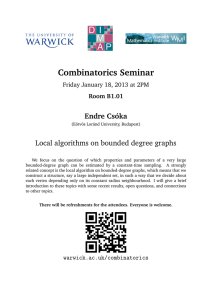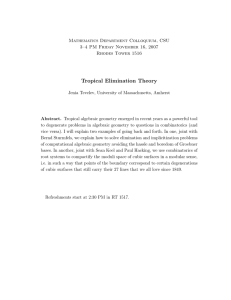Classification
advertisement
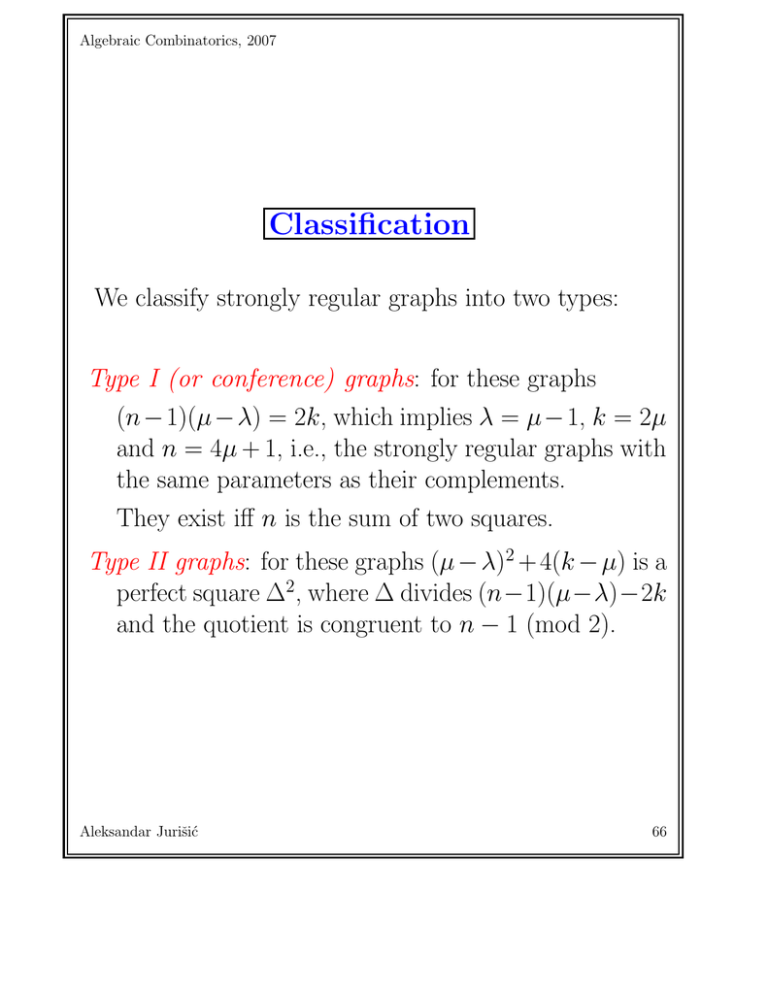
Algebraic Combinatorics, 2007
Classification
We classify strongly regular graphs into two types:
Type I (or conference) graphs: for these graphs
(n − 1)(µ − λ) = 2k, which implies λ = µ − 1, k = 2µ
and n = 4µ + 1, i.e., the strongly regular graphs with
the same parameters as their complements.
They exist iff n is the sum of two squares.
Type II graphs: for these graphs (µ − λ)2 + 4(k − µ) is a
perfect square ∆2, where ∆ divides (n−1)(µ−λ)−2k
and the quotient is congruent to n − 1 (mod 2).
Aleksandar Jurišić
66
Algebraic Combinatorics, 2007
Paley graphs
q a prime power, q ≡ 1 (mod 4) and set F = GF(q).
The Paley graph P (q)= (V, E) is defined by:
V = F and E = {(a, b) ∈ F × F | (a − b) ∈ (F∗)2}.
i.e., two vertices are adjacent if their difference is a nonzero square. P (q) is undirected, since −1 ∈ (F∗)2.
Consider the map x → x + a, where a ∈ F, and the
map x → xb, where b ∈ F is a square or a nonsquare,
to show P (q) is strongly regular with
q−1
q−5
q−1
, λ=
and µ =
.
valency k =
2
4
4
Aleksandar Jurišić
67
Algebraic Combinatorics, 2007
Seidel showed that these graphs are uniquely
determined with their parameters for q ≤ 17.
There are some results in the literature showing that
Paley graphs behave in many ways like random graphs
G(n, 1/2).
Bollobás and Thomason proved that the Paley graphs
contain all small graphs as induced subgraphs.
Aleksandar Jurišić
68
Algebraic Combinatorics, 2007
Krein conditions
Of the other conditions satisfied by the parameteres of
SRG, the most important are the Krein conditions,
first proved by Scott using a result of Krein from
harmonic analysis:
(σ + 1)(k + σ + 2στ ) ≤ (k + σ)(τ + 1)2
and
(τ + 1)(k + τ + 2στ ) ≤ (k + τ )(σ + 1)2.
Some parameter sets satisfy all known necessary
conditions. We will mention some of these.
Aleksandar Jurišić
69
Algebraic Combinatorics, 2007
If k > s > t eigenvalues of a strongly regular graph,
then the first inequality translates to
(2t + 1)(t − s) − t(t + 1)
k ≥ −s
,
(t − s) + t(t + 1)
(t − s) − t(t + 3)
,
(t − s) + t(t + 1)
(t − s) − t(t + 1)
µ ≥ −s(t + 1)
,
(t − s) + t(t + 1)
A strongly regular graph with parameters (k, λ, µ)
given by taking equalities above, where t and s are
integers such that t − s ≥ t(t + 3) (i.e., λ ≥ 0) and
k > t > s is called a Smith graph.
λ ≥ −(s + 1)t
Aleksandar Jurišić
70
Algebraic Combinatorics, 2007
A strongly regular graph with eigenvalues k > σ > τ is
said to be of (negative) Latin square type when
µ = τ (τ + 1) (resp. µ = σ(σ + 1)).
The complement of a graph of (negative) Latin square
type is again of (negative) Latin square type.
A graph of Latin square type is denoted by Lu(v),
where u = −σ, v = τ − σ and it has the same
parameters as the line graph of a TDu(v).
Graphs of negative Latin square type ware introduced
by Mesner, and are denoted by NLe(f ), where e = τ ,
f = τ − σ and its parameters can be obtained from
Lu(v) by replacing u by −e and v by −f .
Aleksandar Jurišić
71
Algebraic Combinatorics, 2007
More examples of strongly regular graphs:
L(Kv ) is strongly regular with parameters
v
n=
, k = 2(v − 1), λ = v − 2, µ = 4.
2
For v 6= 8 this is the unique srg with these parameters.
Similarly, L(Kv,v ) = Kv × Kv is strongly regular, with
parameters
n = v 2, k = 2(v − 1), λ = v − 2, µ = 2.
and eigenvalues
1
2(v−1) ,
v−2
2(v−1)
,
−2
(v−1)2
.
For v 6= 4 this is the unique srg with these parameters.
Aleksandar Jurišić
72
Algebraic Combinatorics, 2007
Steiner graph is the block (line) graph of a 2-(v, s, 1)
design with v − 1 > s(s − 1), and it is strongly regular
with parameters
v
v−1
−1 ,
n = 2s , k = s
s−1
2
v−1
− 2 + (s − 1)2, µ = s2.
s−1
and eigenvalues
2 v−1
v−s
, −sn−v .
k 1,
s−1
λ=
Aleksandar Jurišić
73
Algebraic Combinatorics, 2007
When in a design D the block size is two, the number of
edges of the point graph equals the number of blocks
of the design D. In this case the line graph of the
design D is the line graph of the point graph of D.
This justifies the name: the line graph of a graph.
A point graph of a Steiner system is a complete graph,
thus a line graph of a Steiner system S(2, v) is the
line graph of a complete graph Kv , also called the
triangular graph.
(If D is a square design, i.e., v − 1 = s(s − 1), then its
line graph is the complete graph Kv .)
Aleksandar Jurišić
74
Algebraic Combinatorics, 2007
The fact that Steiner triple system with v points
exists for all v ≡ 1 or 3 (mod 6) goes back to
Kirkman in 1847. More recently Wilson showed that
the number n(v) of Steiner triple systems on an
andmissible number v of points satisfies
n(v) ≥ exp(v 2 log v/6 − cv 2).
A Steiner triple system of order v > 15 can be
recovered uniquely from its line graph, hence there
are super-exponentially many SRG(n, 3s, s + 3, 9), for
n = (s + 1)(2s + 3)/3 and s ≡ 0 or 2 (mod 3).
Aleksandar Jurišić
75
Algebraic Combinatorics, 2007
For 2 ≤ s ≤ v the block graph of a transversal
design TD(s, v) (two blocks being adjacent iff they
intersect) is strongly regular with parameters n = v 2,
k = s(v−1), λ = (v−2)+(s−1)(s−2), µ = s(s−1).
and eigenvalues
s(v − 1)1, v − ss(v−1), −s(v−1)(v−s+1).
Note that a line graph of TD(s, v) is a conference graph
when v = 2s−1. For s = 2 we get the lattice graph
Kv × K v .
Aleksandar Jurišić
76
Algebraic Combinatorics, 2007
The number of Latin squares of order k is
asymptotically equal to
exp(k 2 log k − 2k 2)
Theorem (Neumaier). The strongly regular
graph with the smallest eigenvalue −m, m ≥ 2
integral, is with finitely many exceptions, either a
complete multipartite graph, a Steiner graph, or
the line graph of a transversal design.
Aleksandar Jurišić
77
